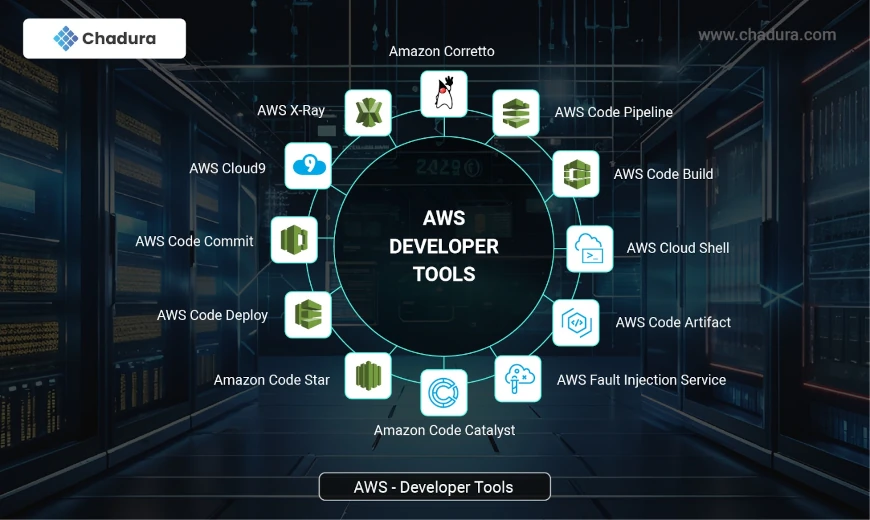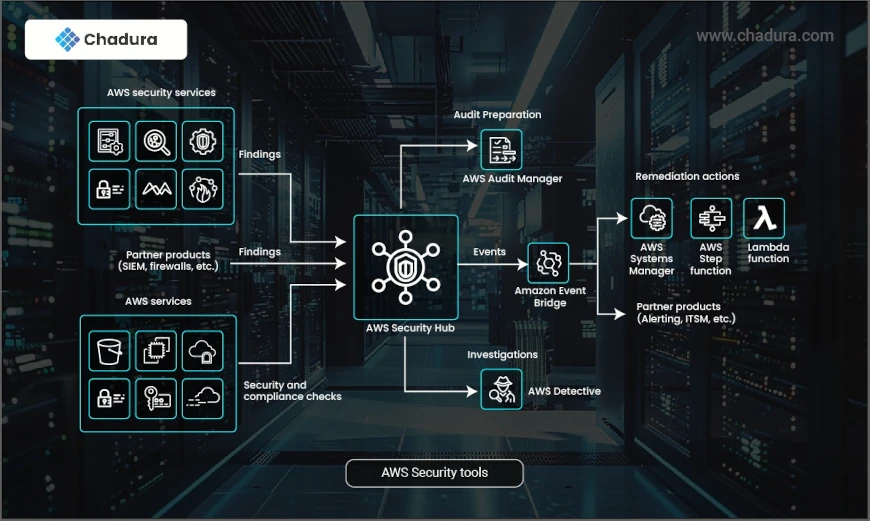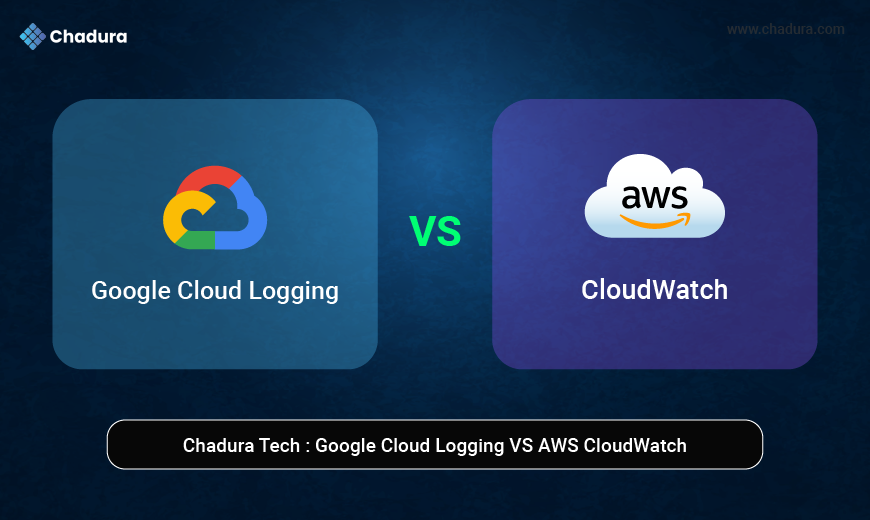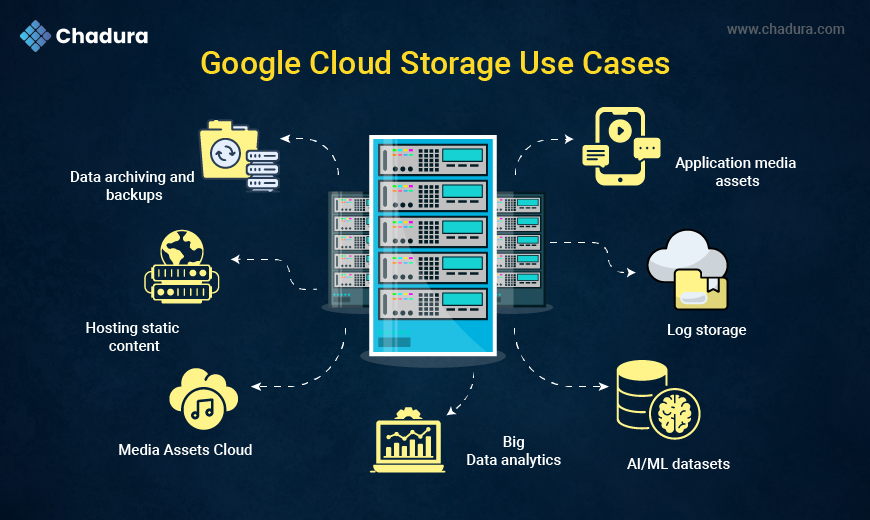Part - V of Part I | Part II | Part III | Part IV | Part V
AWS - Security, Management and Developer Tools
AWS Security Tools
AWS security tools provide a comprehensive set of services designed to protect data, applications, and infrastructure within the cloud. These tools help businesses secure their AWS environments by managing access, monitoring for threats, encrypting sensitive data, and ensuring compliance. Key AWS security tools include:
AWS Identity and Access Management (IAM) – Enables secure control of access to AWS resources by managing users, roles, and permissions.
AWS Shield – Protects against DDoS attacks, ensuring high availability and security for applications.
Amazon GuardDuty – Detects malicious activity and unauthorized behavior using continuous threat monitoring across AWS accounts.
AWS WAF (Web Application Firewall) – Safeguards web applications from common vulnerabilities and attacks, such as SQL injection and cross-site scripting.
AWS Key Management Service (KMS) – Manages encryption keys to protect data at rest and in transit.
AWS Security Hub – Provides a central dashboard for security management, aggregating findings from various AWS services and third-party tools.
AWS CloudTrail – Tracks user activity and API calls to help with auditing and compliance.
AWS Config – Continuously monitors and records AWS resource configurations for security and compliance auditing.
Amazon Macie – Uses machine learning to discover and protect sensitive data, such as Personally Identifiable Information (PII), in Amazon S3.
AWS Secrets Manager – Manages and secures sensitive information like passwords, API keys, and database credentials.
Top 4 Application Security Tools
1. Amazon Inspector
2. AWS Shield
3. AWS Web Application Firewall
4. AWS Secrets Manager
6. AWS Developer Tools
AWS offers a suite of Developer Tools that help developers build, test, and deploy applications in the cloud efficiently and at scale. These tools are designed to streamline the development process, automate workflows, and integrate with existing CI/CD pipelines. Key AWS Developer Tools include:

AWS CodeCommit
A fully managed source control service that hosts Git repositories. It enables teams to collaborate on code and track changes in a secure and scalable environment.
AWS CodeBuild
A fully managed build service that compiles source code, runs tests and produces software packages ready for deployment. It automates the build process and scales according to demand.
AWS CodeDeploy
An automated deployment service that helps developers easily deploy applications to a variety of compute services, including Amazon EC2, Lambda, and on-premises servers. It supports rolling updates and can minimize downtime during deployment.
AWS CodePipeline
A fully managed continuous integration and continuous delivery (CI/CD) service that automates the build, test, and deployment pipelines for faster and more reliable application releases. It integrates with other AWS Developer Tools as well as third-party services.
AWS CodeStar
A unified user interface that enables developers to quickly set up, manage, and automate their CI/CD workflows. CodeStar integrates with multiple AWS services, allowing for streamlined development, from code creation to deployment.
AWS X-Ray
A service that helps developers analyze and debug distributed applications. It provides insights into performance bottlenecks, errors, and latency in applications running on AWS, making it easier to diagnose and fix issues.
AWS Cloud9
A cloud-based integrated development environment (IDE) that allows developers to write, run, and debug code from anywhere. It comes with built-in collaboration features and integrates with other AWS services for streamlined development.
AWS Lambda
A serverless compute service that lets developers run code in response to events without provisioning or managing servers. AWS Lambda automatically scales and integrates with other AWS services for efficient application development.
AWS Elastic Beanstalk
A Platform-as-a-Service (PaaS) offering that makes it easy to deploy, manage, and scale web applications and services. Developers can focus on writing code while Elastic Beanstalk handles the deployment and infrastructure management.
AWS Amplify
A development platform designed for building mobile and web applications. AWS Amplify simplifies integrating cloud services such as authentication, APIs, and storage and allows developers to focus on app features rather than backend infrastructure
7. AWS Management Tools
AWS Management Tools are a suite of services designed to help businesses manage, monitor, and automate their AWS infrastructure, enabling better control over cloud environments and operational efficiency. These tools help users optimize resource usage, track performance, automate workflows, and ensure compliance.
Key AWS Management Tools
1.AWS CloudFormation
A service that enables users to define and provision AWS infrastructure using code. With CloudFormation templates, users can automate the creation and management of AWS resources like EC2 instances, VPCs, and databases in a repeatable and predictable way.
2. AWS CloudWatch
A monitoring and observability service that provides real-time insights into AWS resources and applications. CloudWatch collects and tracks metrics, logs, and events, allowing users to set alarms and automate responses to changes in resource states.
3. AWS Systems Manager
A unified interface that allows users to manage and automate administrative tasks across AWS resources and on-premises environments. Systems Manager includes features like patch management, configuration compliance, automation of tasks, and inventory management.
4. AWS Trusted Advisor
An online resource that helps you reduce cost, increase performance, and improve security by providing best practice recommendations. Trusted Advisor evaluates AWS resources and provides real-time guidance in areas such as cost optimization, performance, security, fault tolerance, and service limits.
5. AWS Config
A service that provides AWS resource configuration tracking and compliance auditing. AWS Config continuously monitors the configuration of AWS resources, allowing users to maintain compliance with internal and external regulations, and to assess the impact of changes in real-time.
6. AWS Organizations
A service that allows you to create and manage multiple AWS accounts in a consolidated way. It helps with central billing, resource management, and applying governance policies across all accounts within an organization.
7. AWS License Manager
A service that simplifies the management of software licenses across AWS and on-premises environments. License Manager helps you track and manage license compliance, ensuring that organizations stay within their licensing terms.
8. AWS Cost Explorer
A tool that enables users to visualize and analyze their AWS spending. With Cost Explorer, you can view historical costs, forecast future expenses, and identify opportunities to optimize costs across AWS services.
9. AWS Budgets
A tool that allows users to set custom budgets for AWS services. AWS Budgets tracks your spending against those budgets, sending alerts when your costs or usage exceed predefined thresholds.
10. AWS CloudTrail
A service that provides detailed logs of all API calls made in your AWS account. CloudTrail helps monitor activity and enables auditing of all interactions with AWS services, making it useful for security, compliance, and operational troubleshooting.
11. AWS Service Catalog
A service that allows you to create and manage catalogs of approved resources within your organization. Service Catalog helps maintain consistency, improve compliance, and reduce provisioning time for users.
12. AWS Auto Scaling
A tool that automatically adjusts the capacity of AWS resources, such as EC2 instances and Amazon DynamoDB tables, based on demand. Auto Scaling helps ensure applications maintain performance and cost efficiency.
13. AWS Well-Architected Tool
A service that helps review workloads against AWS best practices. The Well-Architected Tool provides a framework based on five pillars: operational excellence, security, reliability, performance efficiency, and cost optimization.
Benefits of AWS Management Tools
- Automation: Many AWS Management Tools allow you to automate tasks like infrastructure provisioning, patch management, and compliance monitoring, reducing the operational burden.
- Cost Control: Services like Cost Explorer and AWS Budgets help optimize costs by tracking usage and spending, as well as identifying potential savings.
- Compliance and Security: Tools like AWS Config and AWS CloudTrail enable compliance auditing and security monitoring, helping to maintain regulatory standards.
- Performance Monitoring: CloudWatch and Systems Manager offer deep insights into resource health and application performance, allowing for proactive management.
Operational Efficiency: By simplifying resource management and automation, AWS management tools enhance the overall efficiency of cloud operations.
Use Cases
- Cost Optimization: AWS tools like AWS Budgets and Cost Explorer help businesses track and control their cloud spending.
- Compliance Auditing: AWS CloudTrail and AWS Config help organizations meet security and compliance requirements by providing detailed logs and resource configuration tracking.
- Automation of Admin Tasks: AWS Systems Manager and AWS CloudFormation enable the automation of everyday operational tasks and infrastructure provisioning.
- Monitoring and Performance Tuning: AWS services like CloudWatch and AWS Auto Scaling help ensure high availability, performance, and uptime for applications.





